AIA announces the 2014 COTE Top Ten Green Projects
By Bustler Editors|
Tuesday, Apr 22, 2014
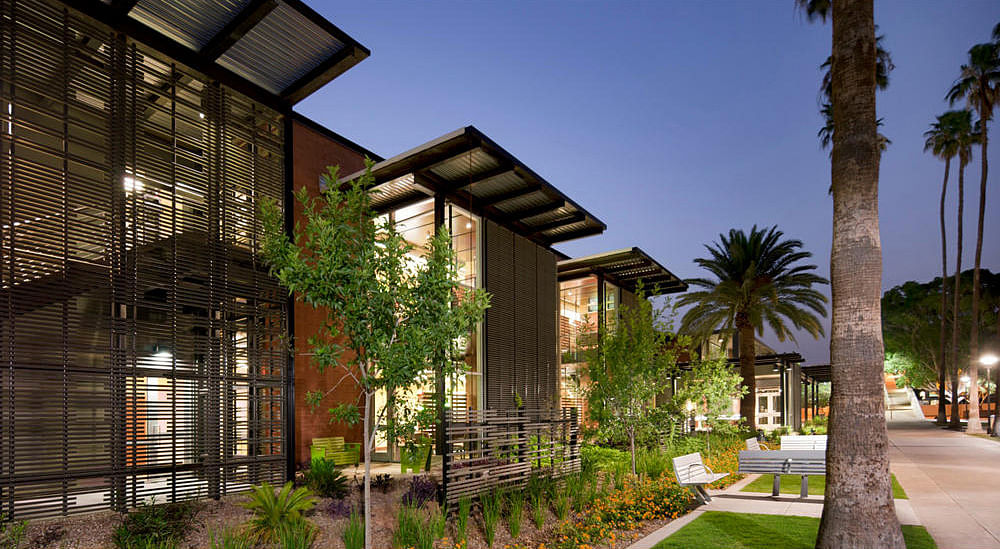
Related
Since it's Earth Day, here are the 18th annual Top Ten Green Projects just announced by the AIA and their Committee on the Environment (COTE). The awards program is the best known in the field for recognizing excellence in sustainable architecture and ecological design.
Additionally, the AIA and COTE chose BNIM Architects' Iowa Utilities Board / Office of the Consumer Advocate Office Building as the Top Ten Plus Project. Now in its second year, the award honors a past Top Ten Green Project recipient that demonstrates through quantifiable metrics the impact of sustainable design and technology.
The winners will be honored at the AIA 2014 National Convention and Design Exposition in Chicago this June.
Have a look at this year's winning projects below.
Arizona State University Student Health Services; Tempe, Arizona
by Lake|Flato Architects + Orcutt|Winslow
Project summary: "The Arizona State University (ASU) Health Services Building is an adaptive reuse project that transformed the existing sterile and inefficient clinic into a clearly organized, efficient, and welcoming facility. The design imbues the new facility with a sense of health and wellness that leverages Tempe’s natural environment and contributes to a more cohesive pedestrian oriented campus. The building’s energy performance is 49% below ASHRAE 90.1-2007, exceeding the current target of the 2030 Challenge. The facility achieved LEED Platinum certification and is one of the best energy performers on campus as evidenced by ASU’s Campus Metabolism interactive web-tool tracking real-time resource use."
For full project details, click here.
Bud Clark Commons; Portland, Oregon
by Holst Architecture
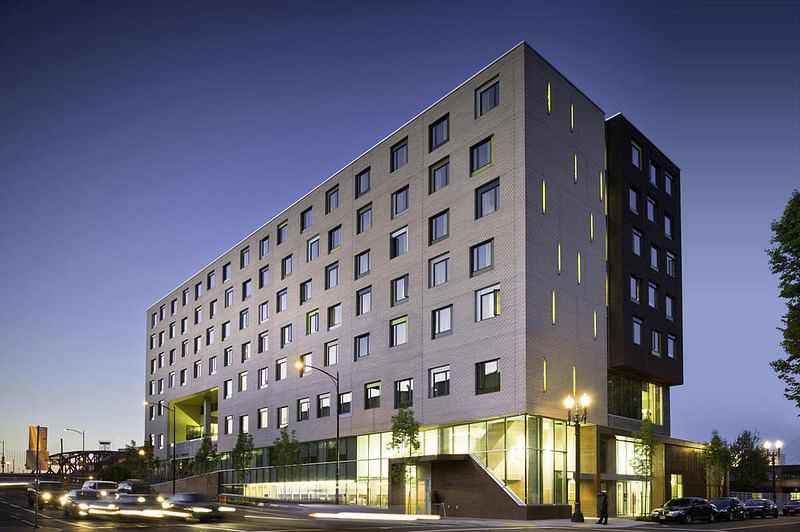
Project summary: "As a centerpiece of Portland’s 10-Year Plan to End Homelessness, this LEED Platinum project provides a continuum of services to help transition homeless individuals toward stable, permanent living arrangements. The architecture helps achieve this goal with a walk-in day center with public courtyard and access to support services; a 90-bed temporary shelter; and a separate and secure entrance to 130 efficient, furnished studio apartments for homeless individuals seeking permanent housing. The building’s design aims to deinstitutionalize services and housing for the most vulnerable in our population. Sustainable features include large-scale graywater recycling, zero stormwater runoff, solar hot water, and a high-performance envelope, resulting in energy savings estimated at $60,000 annually."
For full project details, click here.
Bushwick Inlet Park; Brooklyn, New York
by Kiss + Cathcart, Architects

Project summary: "This project is the first phase of the transformation of the Greenpoint–Williamsburg waterfront from a decaying industrial strip to a multifaceted public park. The design team integrated a program of playfields, public meeting rooms, classrooms, and park maintenance facilities, into a city-block sized site. The park building becomes a green hill on the west side, making 100% of the site usable to the public, and offering views to Manhattan. Below the green roof is a complex of building systems – ground source heat pump wells, rainwater harvest and storage, and drip irrigation. A solar trellis produces half the total energy used in the building."
For full project details, click here.
Edith Green-Wendell Wyatt (EGWW) Federal Building Modernization; Portland, Oregon
by SERA Architects in association with Cutler Anderson Architects
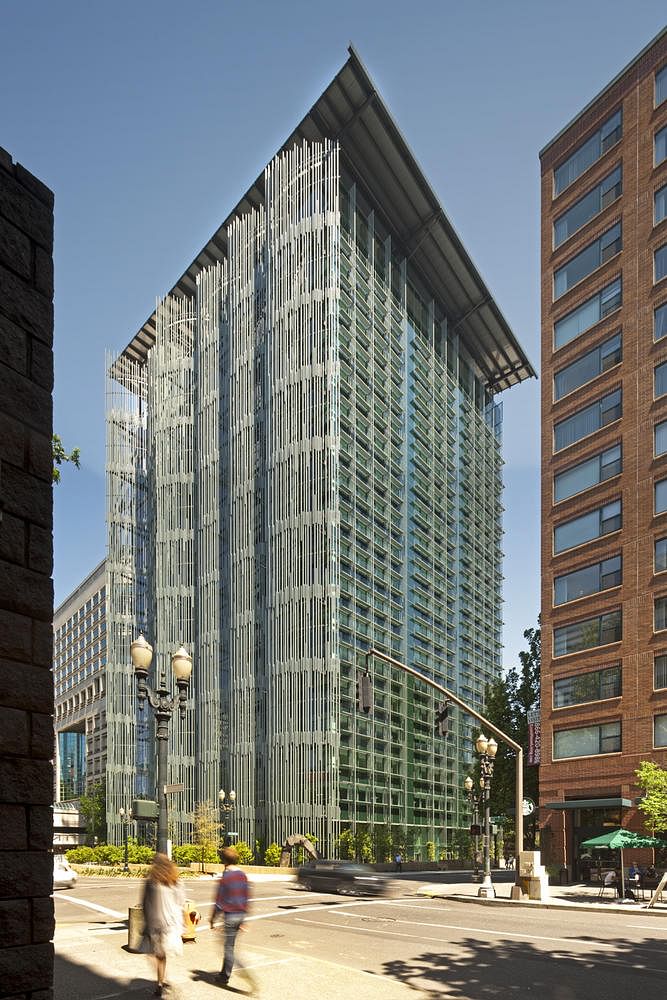
Project summary: "On track to be one of the lowest energy-use buildings in the U.S., EGWW is a model for U.S. General Services Administration nationwide. The project’s goal was to transform the existing building from an aging, energy hog to one of the premiere environmentally-friendly buildings in the nation. With a unique facade of “reeds”, light shelf /sunshades designed by orientation and a roof canopy that supports a 180 kW photovoltaic array while collecting rainwater, EGWW pushes the boundaries for innovative sustainable deign strategies. In addition to the energy improvements, the design reveals the history of the building, exposing the artifacts of the original builders."
For full project details, click here.
Gateway Center - SUNY-ESF College of Environmental Science & Forestry; Syracuse, NY
by Architerra
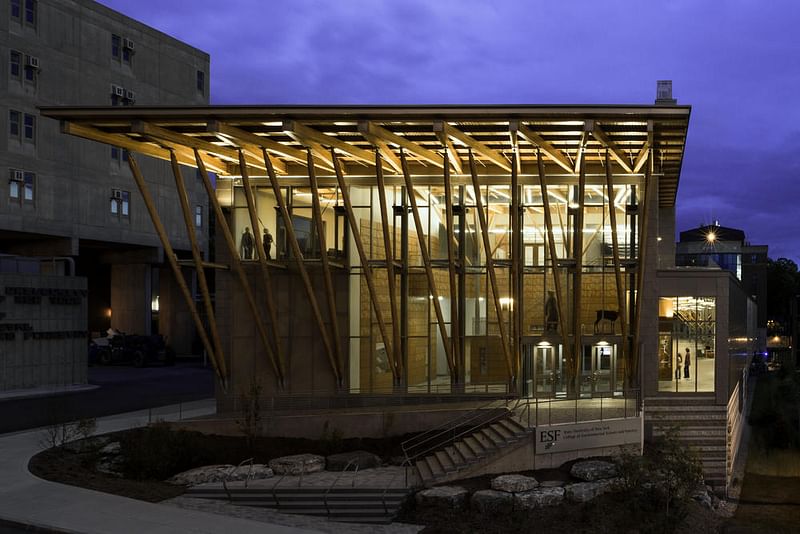
Project summary: "The SUNY-ESF College of Environmental Science & Forestry Gateway Center is a striking symbol of environmental stewardship and climate action leadership. This LEED Platinum campus center meets ESF’s goal of reducing the overall carbon footprint of the campus through net positive renewable energy production, while creating a combined heat and power plant and intensive green roof that serve as hands-on teaching and research tools. The double-ended bioclimatic form exemplifies passive solar design. Net positive energy systems integrated with the design serve four adjacent ESF buildings, providing 60% of annual campus heating needs and 20% of annual power needs."
For full project details, click here.
John & Frances Angelos Law Center; Baltimore
by Behnisch Architekten and Ayers Saint Gross
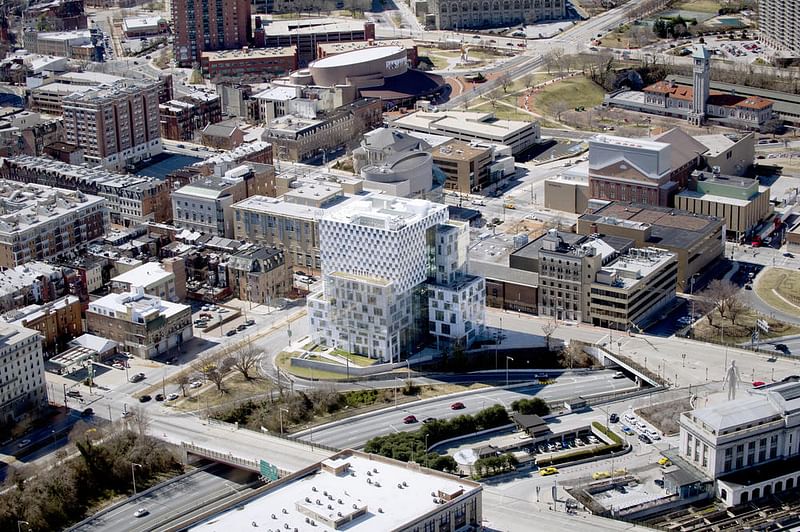
Project summary: "The John and Frances Angelos Law Center is the first large-scale opportunity for the University of Baltimore to demonstrate its intent to pursue strategies that eliminate global warming emissions and achieve climate neutrality. With this in mind, the Law Center is a highly sustainable and innovative structure that strives to reduce reliance on energy and natural resources, minimizing its dependence on mechanical ventilation and artificial lighting of interiors. This is part of a larger comprehensive effort on the part of the A/E team to approach sustainability from a more holistic vantage point from the outset of the project."
For full project details, click here.
Sustainability Treehouse; Glen Jean, West Virginia Design
by Architect: Mithun; Executive Architect/Architect of Record: BNIM

Project summary: "Situated in the forest at the Summit Bechtel Reserve, this interactive, interpretive and gathering facility serves as a unique icon of scouting adventure, environmental stewardship and high performance building design. Visitors ascend indoor and outdoor platforms to experience the forest from multiple vantages and engage with educational exhibits that explore the site and ecosystem at the levels of ground, tree canopy and sky. Innovative green building systems—including a 6,450-watt photovoltaic array output, two 4,000-watt wind turbines, and a 1,000-gallon cistern and water cleansing system—combine to yield a net-zero energy and net-zero water facility that touches its site lightly."
For full project details, click here.
The David and Lucile Packard Foundation Headquarters; Los Altos California
by EHDD
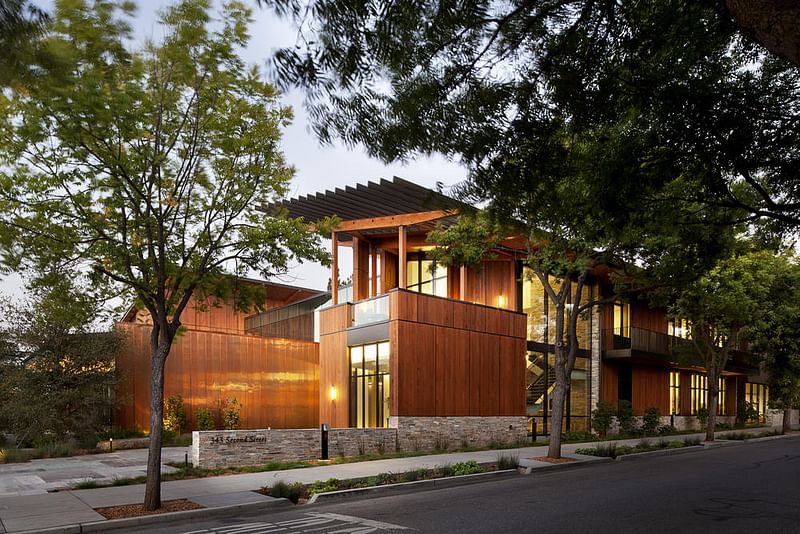
Project summary: "The David and Lucile Packard Foundation headquarters acts as a catalyst for broad organizational sustainability and brings staff, grantees and partners together to solve the world’s most intractable problems. The Foundation's connection to the Los Altos community dates back to its inception in 1964. For the last two decades, as its grant making programs expanded locally and worldwide, staff and operations have been scattered in buildings throughout the city. This project enhances proximity and collaboration while renewing the Foundation’s commitment to the local community by investing in a downtown project intended to last through the end of 21st century."
For full project details, click here.
U.S. Land Port of Entry; Warroad, Minnesota
by Snow Kreilich Architects, Inc.
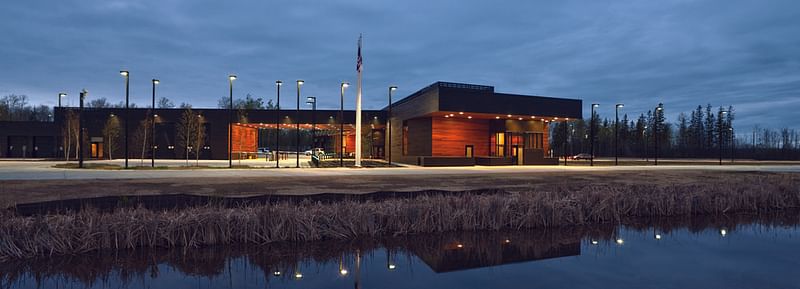
Project summary: "This LEED Gold certified Land Port of Entry is the first to employ a ground source heat pump system. Sustainably harvested cedar was used on the entire exterior envelope, canopies and some interior walls and 98% of all wood on the project is FSC certified. Additionally 22% of the material content came from recycled materials and 91% of all work areas have access to daylight. Rainwater collection, reconstructed wetlands and native plantings address resource and site-specific responses. The facility proudly supports the mission-driven demands of US Customs and Border Protection while addressing the sustainable challenges of our future."
For full project details, click here.
Wayne N. Aspinall Federal Building and U.S. Courthouse; Grand Junction, Colorado
by Westlake Reed Leskosky (Design Architect) and The Beck Group (Architect of Record)
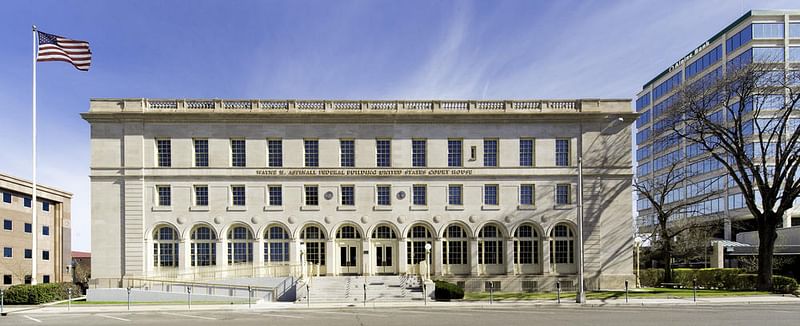
Project summary: "The LEED® Platinum renovation preserves an anchor in Grand Junction, and converts the 1918 landmark into one of the most energy efficient, sustainable historic buildings in the country. The design aims to be GSA’s first Site Net-Zero Energy facility on the National Register. Exemplifying sustainable preservation, it restores and showcases historic volumes and finishes, while sensitively incorporating innovative systems and drastically reducing energy consumption. Features include a roof canopy-mounted 123 kW photovoltaic array, variable-refrigerant flow heating and cooling systems, 32-well passive Geo-Exchange system, a thermally upgraded enclosure, energy recovery, wireless controls, fluorescent and LED lighting, and post-occupancy monitoring."
For full project details, click here.
2014 Top Ten Plus Project:
Iowa Utilities Board / Office of the Consumer Advocate Office Building
by BNIM Architects
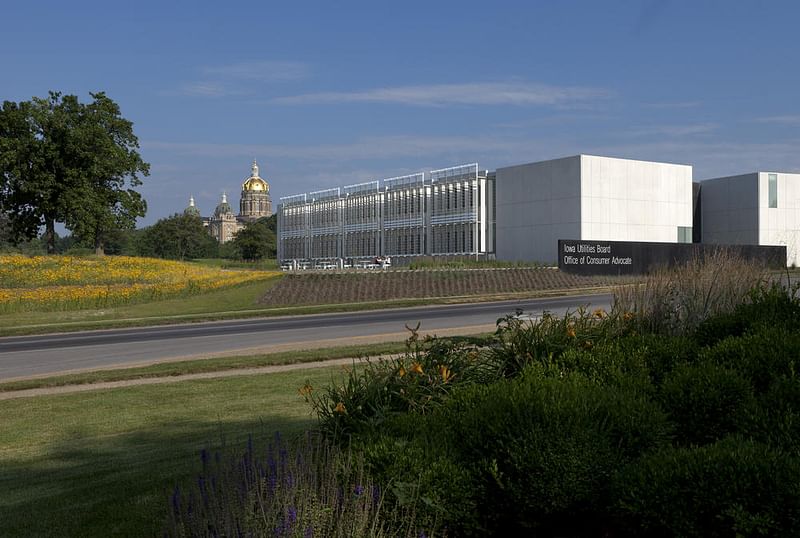
Project summary: "Located within the State of Iowa Capitol Complex, this project is an infill development on the 6-acre site of a former landfill. As a gateway to the complex at its Southeast corner, the project is a figural and literal threshold to the powerful example of government—supported by location and by its demonstration of replicable strategies for performance and savings, proving that the challenge of elegant design and exemplary performance can be solved even within limited budgets. The building is organized in two wings joined by a central lobby. The north wing comprises the State Utilities Board on two levels, while the south wing houses the State’s Consumer Advocate Office on level two and common spaces on level one. It sits as a symbol of the sustainable stewardship of the State of Iowa by demonstrating proven, cost-effective energy efficiency measures."
For full project details, click here.

Share
0 Comments
Comment as :